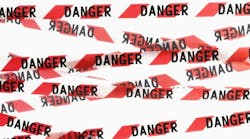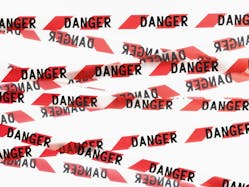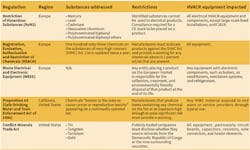In the world of manufacturing today, how and of what a product is made can be as important as how the product performs. Around the world, regulations meant to ensure the safety of those directly or indirectly impacted by a product’s creation are in place. These regulations impact most, if not all, equipment and components at play in the HVACR industry.
Regulations to Consider
There are regulations covering everything from the materials used in a product’s manufacture to volatile organic compounds to the disposal of potentially hazardous items. While some regulations address specific substances, others are broader in scope. In all cases, the primary concern is keeping people safe.
Substance bans. Restriction of Hazardous Substances (RoHS) is a directive prohibiting the use of six chemicals in electric products. The European Union adopted RoHS in 2003 and amended it in 2011 to provide legal clarifications and improve on regulatory conditions. Compliance with RoHS 2, also referred to as RoHS Recast, is required for any product intended to bear the CE mark. The six chemicals prohibited by RoHS are:
- Mercury. Recognized as a highly toxic element, mercury historically has been used in many electric products, including thermostats, flame sensors, switches, relays, and gas regulators.
- Lead. Poisonous to humans and animals, lead historically has been used as a shielding agent and to make solders.
- Cadmium. Another metal considered toxic, cadmium can be found in batteries, solders, stabilizers, and coatings, among other things.
- Hexavalent chromium. A known carcinogen, hexavalent chromium has been used to fight corrosion.
- Polybrominated biphenyls (PBBs). A group of manufactured chemicals that have been linked to adverse effects in the immune and central nervous systems, PBBs are used as flame retardants in plastics.
- Polybrominated diphenyl ethers. Both toxic and resistant to degradation, these organic compounds are used as flame retardants.
Warning requirements. Registration, Evaluation, Authorisation and Restriction of Chemicals (REACH) and California Proposition 65, the Safe Drinking Water and Toxic Enforcement Act of 1986, specify the levels to which certain substances can be used. Products containing chemicals above acceptable levels must carry a warning about the elevated risks.
REACH is a European directive intended to hold manufacturers accountable for understanding and managing chemical risks. Currently, there are 163 chemicals on the list of substances of very high concern (SVHC); a written warning is required for any product containing a listed chemical above a threshold of 0.1 percent wt/wt.
Under Proposition 65, the California Office of Environmental Health Hazard Assessment publishes a continuously updated list of chemicals “known to the state to cause cancer or reproductive toxicity.” Any company wishing to sell products in California must adhere to the act. Manufacturers producing products containing listed chemicals at levels high enough to pose significant risk must provide a written warning to consumers and/or service people who will be exposed to the chemicals through typical use.
While REACH and Proposition 65 relate specifically to toxic chemicals, minerals also are of concern in the United States. As part of the Dodd-Frank Wall Street Reform and Consumer Protection Act, the U.S. Securities and Exchange Commission (SEC) requires all publicly traded companies to disclose (through SEC filings) whether they source tin, tungsten, tantalum, and gold from the Democratic Republic of Congo and the nine surrounding countries, where these substances, known as “conflict minerals,” have been mined to fund local militias. Companies must disclose from where minerals originated, whether or not they have determined the minerals are conflict-free, and their process for determining the status of the minerals.
Disposal. Passed in 2003, the European Union’s Waste Electrical and Electronic Equipment (WEEE) directive makes manufacturers or distributors responsible for the collection, treatment, and environmentally friendly disposal of electrical products. WEEE requires companies to establish an infrastructure for collecting products and forms national “producer compliance schemes,” through which manufacturers and distributors pay an annual fee to centers that handle the collection and recycling of waste electronics. Failure to comply with WEEE could result in prosecution and restrictions on the placing of products in the European Union.
Establishing a Restricted-Substance-Management Program
A restricted-substance-management program is a good way to make sure all levels of an organization know about regulations and, more importantly, their role in ensuring requirements are met. Though not a step-by-step guide, IEC/TR 62476, Guidance for Evaluation of Product With Respect to Substance-Use Restrictions in Electrical and Electronic Products, provides a good framework for a management program.
With any management program, communication is key. First, processes and rules must be communicated to everyone in the organization, and expectations must be clear so that each person understands his or her role in meeting regulations. Second, whether it pertains to chemical content, testing, conflict-minerals reporting, compliance, or something equally critical, proper and valid documentation, as well as data to back up any declarations of conformity, is important to have on hand.
Also important is the performance of risk assessments and final product evaluations. Risk assessments should be performed regularly and consider the type of materials being supplied, the entity supplying the materials, and potential exposures or violations. This can be done in a variety of ways, including requesting and reviewing full laboratory data reports, conducting self-inspections, testing materials supplied by other companies, and audits. Any elevated risk should be addressed as soon as possible.
Other Best Practices
In addition to establishing a management program and instituting formal practices for addressing restricted materials:
- Consider potential exemptions. An exemption—for example, use of a shielding material—might help to sustain a product or brand until suitable non-toxic materials are identified and integrated into production. Be careful with exemptions, however—they expire.
- Educate yourself. Become familiar with the requirements applicable to you. Know what chemicals are on the SVHC and California Proposition 65 lists and the acceptable limits for each. Know the composition of your products. Know the risk levels of your products based on their components, function, and size.
- Monitor regulatory activity. Each of the aforementioned directives has been amended over the years or involves lists that regularly are reviewed and updated. Knowing what is happening with regulatory agencies and staying well-informed regarding changes, challenges, and new requirements can avoid headaches and save time and money.
- Consider compliance throughout the product-development process. Compliance begins during the conceptualization of a product. Designers should consider approved vendors, lists of restricted substances, and information on parts and components. Sourcing departments should qualify suppliers properly. Manufacturing operations should establish and follow procedures in line with requirements. Consider enlisting expert partners to test for toxins and advise on safety concerns, restrictions, and the regulatory space.
Conclusion
Having products considered hazardous and non-compliant poses great risk, as it could bring litigation, negative publicity, and an inability to place products in certain markets. Taking steps to better manage restricted substances can go a long way to benefitting customers, consumers, the environment, and your organization.
Matt Quinn is business-development manager for chemical services for Intertek. For more than 10 years, he has been assisting companies in identifying global environmental requirements and implementing effective compliance solutions.
Did you find this article useful? Send comments and suggestions to Executive Editor Scott Arnold at [email protected].











